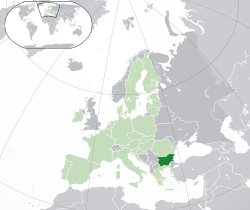|
Bulgaria
XVII Winter Olympic Games – Downhill Skiing
1992 Silver 50 Leva 30mm (10.00 grams) 0.500 Silver (0.1608 oz.
ASW)
Reference: KM# 198
РЕПУБЛИКА БЪЛГАРИЯ 50 ЛЕВА 1992, Wreath.
XVII ЗИМНИ OЛИМПИЙСКИ ИГРИ 1994, Skier.
You are bidding on the exact item pictured, provided with a Certificate of
Authenticity and Lifetime Guarantee of Authenticity.
 The The
1994 Winter Olympics, officially known
as the XVII Olympic Winter Games
(Norwegian: De 19. olympiske
vinterleker; Nynorsk: Dei 19.
olympiske vinterleikane) and commonly known
as Lillehammer ’94, was an
international winter multi-sport event held from
12 to 27 February 1994 in and around
Lillehammer, Norway. Having lost the bid for the
1992 Winter Olympics to Albertville in France,
Lillehammer was awarded the 1994 Winter Games on
15 September 1988, at the 94th IOC Session in
Seoul, South Korea. This was the only Winter
Olympics to take place two years after the
previous edition of the Winter Games, and the
first to be held in a different year from the
Summer Olympics. Lillehammer ’94 was the second
Winter Games hosted in Norway—the first being
the 1952 Winter Olympics in Oslo—and the fourth
Olympics overall to be held in a Nordic country,
after the 1912 Summer Olympics in Stockholm,
Sweden, and the 1952 Summer Olympics in
Helsinki, Finland. Lillehammer is the most
northerly city ever to host the Olympic Games.
Although many of the events took place in Lillehammer, the skating events
were held in Hamar, some ice hockey matches were played in Gjøvik, and the
Alpine skiing events were held in Øyer and Ringebu. Sixty-seven countries and
1,737 athletes participated in six sports and sixty-one events.[1]
Fourteen countries made their Winter Olympic debuts, of which nine were former
Soviet republics. The Games also saw the introduction of stricter qualifying
rules, reducing the number of under-performing participants from warm-weather
countries. New events were two new distances in short track speed skating and
aerials, while speed skating was moved indoors. Almost two million people
spectated at the Games, which were the first to have the Olympic Truce in
effect. The Olympics were succeeded by the 1994 Winter Paralympics from 10 to
19 March.
Manuela Di Centa and Lyubov Yegorova dominated women’s cross-country skiing,
taking five and four medals for Italy and Russia respectively. A crowd of more
than 100,000 saw Italy beat Norway by 0.4 seconds in the men’s 4 × 10 km relay.
Vreni Schneider won a complete set of medals for Switzerland in Alpine skiing,
while Norway took a podium sweep in the men’s combined competition. Figure
skater Nancy Kerrigan won silver in ladies’ singles, despite being attacked a
few weeks before the Games by Tonya Harding’s associate Shane Stant; 16-year-old
Oksana Baiul edged Kerrigan to win the gold medal, marking the first time the
Ukrainian national anthem was played at the Olympics. Johann Olav Koss won three
speed skating golds for Norway, while 13-year-old Kim Yun-mi from South Korea
became the youngest-ever Olympic gold medalist. Sweden defeated Canada in a
dramatic penalty shootout in the ice hockey final. Russia won the most events,
with 11 gold medals, while Norway collected the highest number of medals
overall, winning 26.

Bulgaria (Bulgarian: България, tr. Bǎlgariya), officially the
Republic of Bulgaria (Bulgarian: Република България, tr. Republika
Bǎlgariya, IPA: [rɛˈpublikɐ bɐɫˈɡarijɐ]), is a country in southeastern
Europe. It is bordered by Romania to the north, Serbia and Macedonia to the
west, Greece and Turkey to the south, and the Black Sea to the east. With a
territory of 110,994 square kilometres (42,855 sq mi), Bulgaria is Europe’s
16th-largest country.
 Organised Organised
prehistoric cultures began developing on current Bulgarian lands during the
Neolithic period. Its ancient history saw the presence of the Thracians,
Ancient Greeks, Persians, Celts, Romans, Goths, Alans and Huns. The
emergence of a unified Bulgarian state dates back to the establishment of
the First Bulgarian Empire in 681 AD, which dominated most of the Balkans
and functioned as a cultural hub for Slavs during the Middle Ages. With the
downfall of the Second Bulgarian Empire in 1396, its territories came under
Ottoman rule for nearly five centuries. The Russo-Turkish War of 1877-78 led
to the formation of the Third Bulgarian State. The following years saw
several conflicts with its neighbours, which prompted Bulgaria to align with
Germany in both world wars. In 1946 it became a one-party socialist state as
part of the Soviet-led Eastern Bloc. In December 1989 the ruling Communist
Party allowed multi-party elections, which subsequently led to Bulgaria’s
transition into a democracy and a market-based economy.

Bulgaria’s population of 7.2 million people is predominantly urbanised and
mainly concentrated in the administrative centres of its 28 provinces. Most
commercial and cultural activities are centred on the capital and largest
city, Sofia. The strongest sectors of the economy are heavy industry, power
engineering, and agriculture, all of which rely on local natural resources.
The country’s current political structure dates to the adoption of a
democratic constitution in 1991. Bulgaria is a unitary parliamentary
republic with a high degree of political, administrative, and economic
centralisation. It is a member of the European Union, NATO, and the Council
of Europe; a founding state of the Organization for Security and
Co-operation in Europe (OSCE); and has taken a seat at the UN Security
Council three times.
|





 The
The 
 Organised
Organised 





